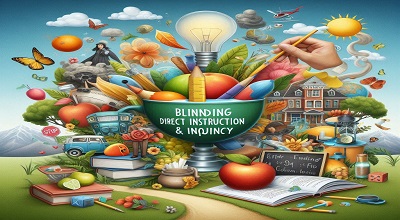Blending Direct Instruction & Inquiry
Blending direct instruction & inquiry-based learning is a pedagogical approach that combines two different teaching methods to create a balanced and effective learning experience for students. This approach acknowledges the benefits of direct instruction. Inquiry-based learning seeks to leverage their strengths to enhance student learning. Here’s a breakdown of each method and how they can be blended:
Direct Instruction:
- Direct instruction is a teacher-centered approach in which the teacher delivers information and concepts to students in a structured and systematic manner.
- It is effective for presenting essential content and building foundational knowledge and skills.
- Key features of direct instruction include clear learning objectives, explicit teaching of concepts, and systematic practice and assessment.
Inquiry-Based Learning:
- Inquiry-based learning is a student-centered approach that encourages students to ask questions, explore topics, and discover knowledge on their own or in collaboration with peers.
- It fosters critical thinking, problem-solving, and a deeper understanding of concepts by engaging students in active learning.
- Key features of inquiry-based learning include open-ended questions, research projects, experiments, and discussions.
Blending Direct Instruction & Inquiry:
Start with Direct Instruction:
- Begin a lesson with a brief direct instruction segment to introduce key concepts, provide context, and set clear learning objectives. This helps students build a foundational understanding of the topic.
Promote Inquiry:
- After the direct instruction, transition to an inquiry-based phase where students are encouraged to ask questions, explore further, and apply what they’ve learned.
- Provide opportunities for students to work on projects, conduct research, or engage in discussions that allow them to actively investigate the topic.
Teacher as a Guide:
- During the inquiry phase, the teacher takes on the role of a facilitator or guide, providing support, resources, and guidance as students explore the topic.
- The teacher can also offer prompts or scaffolding to help students think critically and stay on track.
Assess and Reflect:
- Regularly assess and evaluate student understanding through formative assessments, discussions, and reflections.
- Use these assessments to adjust the balance between direct instruction and inquiry-based learning to meet the needs of the students.
Benefits of Blending Direct Instruction and Inquiry:
- Fosters a balanced approach to teaching and learning.
- Builds a solid foundation of knowledge through direct instruction.
- Encourages critical thinking, problem-solving, and independent learning through inquiry-based methods.
- Addresses various learning styles and preferences.
- Prepares students for real-world problem-solving and research.
Summary
In summary, blending direct instruction & inquiry-based learning can be a powerful way to provide a well-rounded educational experience. That combines the benefits of teacher-led instruction with student-driven exploration. By striking the right balance and adapting to the needs of your students, you can create a dynamic and effective learning environment.
